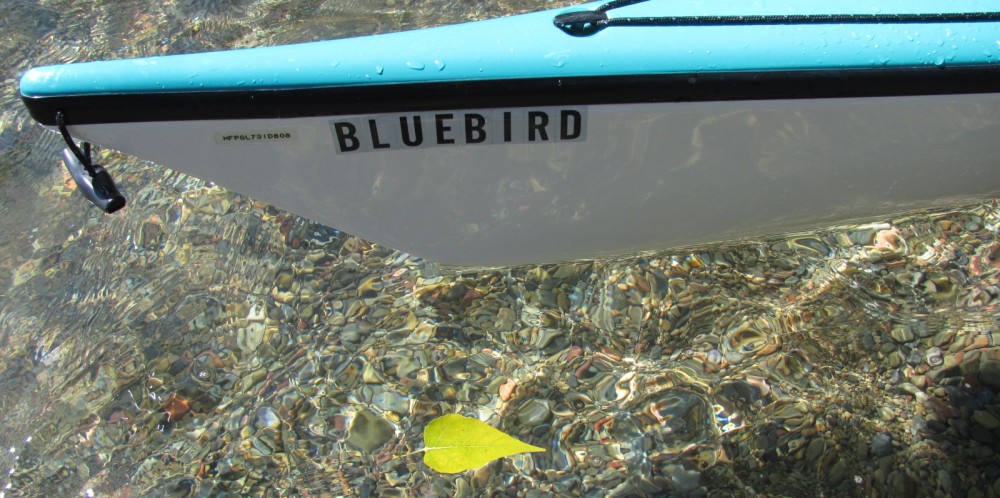(August 21 2009)
And you are ever again the wave
Sweeping through all things
(Rilke, Book of Hours, II, 3)
The semester will soon begin. I want to get in another paddle before I am bound to the routine of classes, office hours, and the internal pressure to try to make each class better than the last time I taught it. I also need a way to discharge the anxiety that accumulates in the final days before I meet my students. With all this in mind, I drive up to Finley Point Campground, arriving at about 10 a.m., and park the truck in the main lot because I am not going to camp. To get a feel for the day I walk out to the point, still shaded by the cottonwoods. I find unusual conditions. The wind is blowing out of the southwest rather than summer’s more typical northeast. I turn to my right and notice several people standing on the docks trying to decide whether to take their boats out on the lake. Something about the conditions causes them to hesitate.
I pause and try to assess them for myself: large swells, unlike any I have ever seen on Flathead Lake, roll toward the north. The distance between rounded crests is much greater than when whitecaps fill the fetch. I am relieved to see that the tops of the waves do not break. If waves this size tipped over and broke I would stay on shore and watch, like a surfer who perches on the cliff and does not carry his board down to the beach. When I see that the wave tops are smooth, even in the shallows of Finley Bay, I decide to proceed. I pull out of the little marina and suddenly feel the full force of the wind and the way the big waves slide under me from behind. For a moment I question the decision to launch and consider turning back. But after a few dozen strokes I begin to feel more at ease: these big swells will not swallow me. I concentrate on my breathing and adjust my paddling rhythm to the rise and fall of the swells. Gradually, the tension leaves my body. After a few minutes I slip into effective and relaxed strokes, riding the remnants of what must have been a great storm.
As I head north I am surprised by my speed. I have never experienced anything like these big, soft swells. It feels good to be moving with rather than against all this energy. If one were inclined toward seasickness, this would not be a good day. I associate this waveform more with the ocean, having seen such waves off the coast of Southern California when I sailed as a young teen with my father. (I later learn from my wife’s uncle—a lifetime ocean sailor, that these are “swell waves”). Though swell waves are normally generated by distant storms on the ocean, I am experiencing the aftermath of a strong late summer storm on the lake. These swells are the remnants of what was once a stormy inland sea.
Carried on the round back of the swells, I quickly pass Horseshoe and Bare Belly Island to the east and notice a large powerboat heading toward an anchorage at the south end of Bird Island. By their quick movements, the people on board seem anxious to get to shore. Perhaps the rolling motion set up by the waves and a rising and falling horizon make seeking solid ground a necessity. I pass them as they wade ashore: they seem visibly relieved to be on land. Still assisted by the waves, I travel up the east shore of Bird Island, round the rocky point on the north end, and enter my favorite bay.
I explore the island on foot, cross through the island to the east shore, struggle over deadfall, duck limbs and spider webs. Once through the tangle, I finally break into the open and look to the Mission Mountains. I decide to walk the shoreline back to my boat and bay. I hop rocks and wade through shallows. By setting my miniature tripod in the water I take a few pictures to get a water-level view across the bay. By the time I get back to my boat I need to cool off. I tuck my camera back into its waterproof case, climb the rocks and dive off several times, taking a few breast strokes into deeper water before turning around, swimming to shore and doing it again. I let the sun and air dry me as I eat my lunch.
Refreshed now, and seeing that the swells have dropped, I paddle the long open stretch between Bird Island and Matterhorn Point. The old Texaco sign now seems like a tall friend or sentry. I slip between the rocks on the point and shore, rest briefly, then cross back to Black Point. From here I head south to Safety Bay, a deep little fiord that is well named. Finding no place to land for another rest, I keep going, cross the narrow channel to Bull Island, round it and then cross back to Finley Point through The Narrows.
This trip, even through today’s swells, seemed relatively easy for a couple of reasons. I am near the end of a season of paddles. Having paddled as often as I could, I have increased my stamina. Time on the water and conscious effort to improve my forward stroke have helped me cover the day’s distance without feeling tired. This was a perfect 13-14 mile paddle, a mix of open water and close, shoreline details. If this is the last paddle of the season I will feel content. These high season summer days, with mostly clear skies and water that feels fairly warm, seem to pass as swiftly as geese riding the wind.

